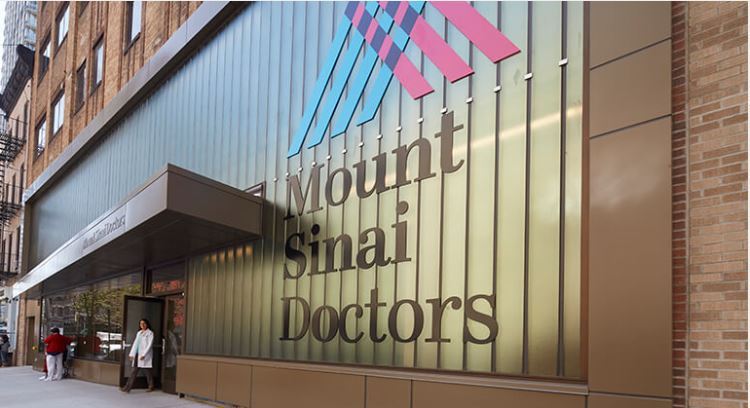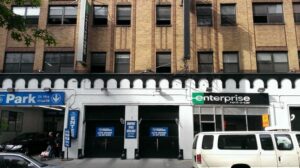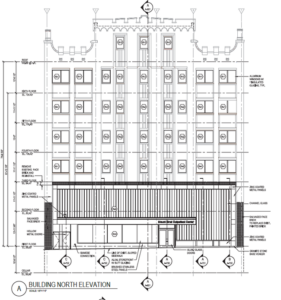 Photo credit Mount Sinai.
Photo credit Mount Sinai. Subscribe Now
New Building Systems Help Transform Parking Garage into Medical Facility
By William Procz and Isaac Doris
The Mount Sinai Health System is New York City’s largest academic medical system, with eight hospitals, a leading medical school and a vast network of ambulatory practices throughout the greater New York region. To accommodate growth in its multi-specialty medical practice, Mount Sinai sought to open a new outpatient facility in the Yorkville neighborhood of Manhattan’s Upper East Side.
 A former parking garage located on East 85th Street — one subway stop away from Mount Sinai’s main campus — proved to be an ideal location. The transformation of the six-story building, originally constructed in 1930, presented a number of engineering challenges, however. Existing ceiling heights, local noise ordinances and insufficient gas pressure from the street all had to be factored into the design of the building’s new mechanical, electrical and plumbing systems.
A former parking garage located on East 85th Street — one subway stop away from Mount Sinai’s main campus — proved to be an ideal location. The transformation of the six-story building, originally constructed in 1930, presented a number of engineering challenges, however. Existing ceiling heights, local noise ordinances and insufficient gas pressure from the street all had to be factored into the design of the building’s new mechanical, electrical and plumbing systems.
A challenging adaptive reuse project
Due diligence confirmed the potential to renovate and extend the life of the 50,000-square-foot building rather than proceed with demolition and new construction. Mount Sinai administrators appreciated the opportunity to pursue the more sustainable option, which would avoid significant material and carbon waste. The health system turned to the team of Freeman White and Vanderweil Engineers to design the transformation, including the installation of all new engineering systems suitable for medical use and compliance with codes and noise ordinances. The work included multiple utility services; new mechanical, electrical, plumbing and life safety systems and a natural gas emergency generator for standby power.
Minimizing noise in residential neighborhood
A residential building with balconies is located directly behind the building. This required the team to design the generator and other new roof equipment to meet New York City’s strict noise ordinance specifications. The generator, air handling unit and cooling tower were enclosed in custom, sound-attenuated enclosures.
Proactive measures
 While much of the building’s façade was retained, most of the interiors — including the garage’s car lifts — were gutted. Existing ceiling heights were still in place, however, which complicated the routing of new ductwork. A creative routing scheme, requiring careful communications between the architect and the engineering team, as well as early coordination of all new utilities with the New York City Building Department and utility providers, proved crucial to the success of the project.
While much of the building’s façade was retained, most of the interiors — including the garage’s car lifts — were gutted. Existing ceiling heights were still in place, however, which complicated the routing of new ductwork. A creative routing scheme, requiring careful communications between the architect and the engineering team, as well as early coordination of all new utilities with the New York City Building Department and utility providers, proved crucial to the success of the project.
The solutions chosen by the design team will allow the building to address New York City’s Local Law 97, requiring that most buildings over 25,000 square feet comply with strict greenhouse gas emission limits by 2024. The team designed an energy-efficient, electric water-source heat pump system for the building before the law had even taken effect. Sustainable features include an air-to-air heat recovery exchanger within the custom dedicated outside air system and premium efficiency heat pumps with ECM motors.
Reliable power supply
With emergency and standby generator systems vital to the operation of the building and ongoing patient care, the use of a natural gas generator was preferred. In 2012, Hurricane Sandy revealed one of the drawbacks of diesel generators: the delay in fuel deliveries due to widespread storm damage. Natural gas generators are also quieter, and have a reduced environmental footprint. Vanderweil’s custom solution, including the installation of a 250 kW voluntary natural gas generator, required special approval from the city’s building department, as existing codes require an onsite fuel supply — usually favoring the use of diesel.
Because the gas pressure available from the street was insufficient to start a generator, the project required duplex booster pumps with a redundant uninterruptible power supply for the power source. A second UPS serves both the main distribution frame room and the bypass input to the booster pump UPS.
Now open and serving patients, the building is an excellent example of the creative and sustainable reuse of New York City’s aging inventory of buildings. A complex renovation — converting a mid-block parking garage constructed nearly a century ago into state-of-the-art facilities for medical care — proves that buildings can be economically salvaged to serve new purposes, conserving both budgets and natural resources.
Additional project team members included structural engineer Stratford Engineering, and acoustical consultant Lally Acoustical Consulting LLC.
Author: William Procz and Isaac Doris
William Procz, PE, LEED AP, is a principal in the Princeton, New Jersey office of Vanderweil. Isaac Doris, P.E., is an associate and senior electrical engineer in the New York City office of Vanderweil.
Tags: Adaptive Reuse, Construction
Posted November 15, 2021
More Articles:
- Coverings 2024
Apr 22, 2024 – Apr 25, 2024 - Hospital, Outpatient Facilities & Medical Office Buildings Summit
Apr 25, 2024 – Apr 25, 2024 - CxA Workshop & Exam
Apr 29, 2024 – Apr 30, 2024 - EMP Seminar & Exam at CxEnergy 2024
Apr 29, 2024 – Apr 30, 2024 - CxEnergy
Apr 29, 2024 – May 2, 2024 - PHCC West 2024
Apr 29, 2024 – May 2, 2024 - Lean in Design Forum 2024
May 1, 2024 – May 2, 2024










